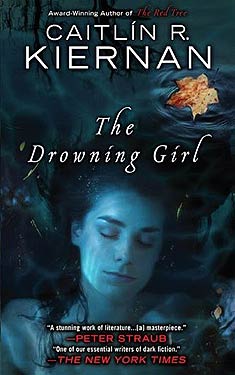WoGF Review: The Drowning Girl by Caitlín R. Kiernan
 Allie McCarn (Allie), reviews science fiction and fantasy books on her blog Tethyan Books. She has contributed many great book reviews to WWEnd including several Grand Master reviews featured in our blog. Allie has just kicked off a new blog series for WWEnd called New Voices where she’ll be reviewing the debut novels of relatively new authors in the field.
Allie McCarn (Allie), reviews science fiction and fantasy books on her blog Tethyan Books. She has contributed many great book reviews to WWEnd including several Grand Master reviews featured in our blog. Allie has just kicked off a new blog series for WWEnd called New Voices where she’ll be reviewing the debut novels of relatively new authors in the field.
Editor’s Note: This review counts for October.
 The Drowning Girl by Caitlín R. Kiernan
The Drowning Girl by Caitlín R. Kiernan
Published: Roc, 2012
Awards Won: Stoker Award, Co-Winner of the James Tiptree, Jr. Award.
Awards Nominated: Nebula Award, Shirley Jackson Award, Locus F Award, Mythopoeic Award, World Fantasy Award
The Book:
“India Morgan Phelps (Imp) is a mentally ill woman who is also haunted, for a certain definition of the word ‘haunted’. Her ghost story involves mermaids and wolves and two women rescued from the side of the road. One is Abalyn, a transgender woman who becomes an integral part of Imp’s life. Another is Eva Canning, a mysterious woman who brings chaos with her.
In her journal, Imp tells the story of the time(s) she met Eva Canning, and tries to separate truth and fact, in order to come to terms with the events of one summer and/or fall—both the events that happened, and those that did not. The facts may never be clear, but perhaps the truth can be found.” ~Allie
This is my 10th novel for the Women of Genre Fiction Reading Challenge, and with this review, I am officially back on track to finish within the scheduled year! This novel is also my entry for the Readers Imbibing Peril event over at Stainless Steel Droppings.
My Thoughts:
 The Drowning Girl is a very difficult book to describe, both because of the creative style of the story and its ambiguity. The story is told through Imp’s journals, and she is an unreliable narrator with a very distinct voice. Imp has no intention of telling a linear story, and she often rambles or skips in time to tell a part of the story that is less distressing. She interrupts and argues with herself in the text, and constantly repeats or refers back to previous information. Her voice also changes dramatically with her state of mind, and one memorable chapter in particular contains a very disordered but poetic stream of consciousness account. Instead of moving chronologically through the events, it seems like Imp is slowly building up an orchestra of moods, information and ideas that can be employed to describe the significance and tone of events and to imply their connections to one another.
The Drowning Girl is a very difficult book to describe, both because of the creative style of the story and its ambiguity. The story is told through Imp’s journals, and she is an unreliable narrator with a very distinct voice. Imp has no intention of telling a linear story, and she often rambles or skips in time to tell a part of the story that is less distressing. She interrupts and argues with herself in the text, and constantly repeats or refers back to previous information. Her voice also changes dramatically with her state of mind, and one memorable chapter in particular contains a very disordered but poetic stream of consciousness account. Instead of moving chronologically through the events, it seems like Imp is slowly building up an orchestra of moods, information and ideas that can be employed to describe the significance and tone of events and to imply their connections to one another.
The tools Imp used to build her story come from a wide variety of sources, both real and fictional. Imp references many different artists (including Radiohead), in addition to well-known events and ideas (l’inconnue de la Seine, Kuroi Jukai, etc.). She also uses a variety of fictional cultural influences, such as the artist Phillip George Saltonstall, who created the painting, The Drowning Girl, and Albert Perrault, a modern artist who was obsessed with Little Red Riding Hood. Imp’s own art and writings also play a role in the story. All of these pieces were used to build the tone of each scene, and to imply the significance of, for instance, Eva as a mermaid or as a wolf. While I would not call this a scary story, the atmosphere is certainly often dark and unsettling.
Within this rambling style, eerie mood, and wealth of real and fictional art, The Drowning Girl tells a story of three women. I think Imp was a much more sympathetic character because the reader was allowed into her personal thoughts. She was not always the easiest person to handle, and I couldn’t help but wince at some of the things she said to Abalyn. From inside her mind, though, one could see the frustration and confusion that led to her outbursts. Abalyn was probably the most likeable character of the story, a geek who wrote reviews of video games for a living. Her personality was extremely different from Imp’s, but they seemed to complement each other well. Eva Canning, the third main actor in the story, was simply mysterious. The story was something of a challenge to piece together, and I’m not sure I have everything completely clear, even at the end. I enjoyed the journey through Imp’s story, though, and I think the conclusion was well suited the style of the story.
My Rating: 4.5/5
The Drowning Girl can be a confusing book, but it is also a fascinating one. Told from the point of view of a very mentally ill woman named Imp, the story follows her relationship with Abalyn, and her encounter(s) with a mysterious woman named Eva Canning (who might be a ghost, a wolf, a mermaid…). Imp weaves her story with cultural references both real and fictional, building an unsettling tapestry of a ghost story from each thread. Less an account of a series of events, the novel is more about Imp’s experiences, perceptions and state of mind. It’s definitely not a traditional ghost story, but it is a novel that is atmospheric, immersive, and creative.



















 Full Details
Full Details


No comments yet.
Sorry, the comment form is closed at this time.